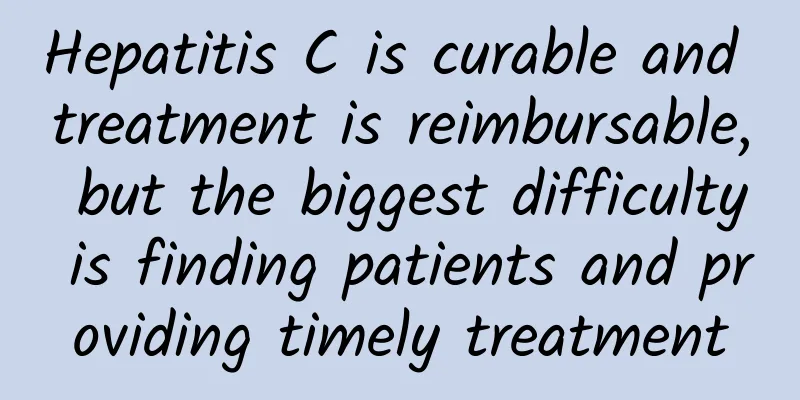Hepatitis C is curable and treatment is reimbursable, but the biggest difficulty is finding patients and providing timely treatment

|
Hepatitis C treatment in China has entered a new era of direct antiviral treatment. This year's updated national medical insurance catalogue included three direct antiviral drugs, including Elbavir and Grazoprevir tablets, for the first time, which greatly alleviated the treatment burden on patients. Today, when hepatitis C is curable and treatment is reimbursable, the conditions for eliminating hepatitis C in China are ripe, but to achieve this goal, the problems of low screening rates, low consultation rates, and low treatment rates are still obstacles. On November 14, the "Eliminating Hepatitis C, Responsibility" National Chronic Hepatitis C Standardized Diagnosis and Treatment Project initiated by the China Hepatitis Prevention and Control Foundation was launched in Beijing. "There are at least 7 million hepatitis C patients in my country. Currently, there are only about 200,000 hepatitis C cases found in my country each year, which is still a long way from the goal of eliminating viral hepatitis proposed by the World Health Organization." Wang Guiqiang, chairman of the Infectious Diseases Branch of the Chinese Medical Association and director of the Infectious Diseases Department of Peking University First Hospital, pointed out at the launch conference of the above project. This also means that there are still millions of hepatitis C patients in my country who have not been discovered. The Paper noted that at the launch meeting of the above project, many experts expressed the need to proactively screen, intervene, and increase drug accessibility, find patients, and allow new hepatitis C drugs that are included in medical insurance to be implemented in order to achieve the goal of eliminating hepatitis C as soon as possible. Where are the millions of hepatitis C patients at the grassroots level? Wang Guiqiang, who works in the Department of Infectious Diseases at Peking University First Hospital, has not encountered many hepatitis C patients. "Now the diagnosis and treatment of hepatitis C is very good in large hospitals and big cities. We can't find hepatitis C patients when doing clinical research in Beijing. It's not that there are no patients, but a large number of hepatitis C patients are at the grassroots level." Wang Guiqiang said that factors such as sanitary conditions and public awareness at the grassroots level have affected the screening, diagnosis and treatment of hepatitis C. The Paper noted that the national standardized diagnosis and treatment project for chronic hepatitis C, "Eliminating Hepatitis C, Our Responsibility," initiated by the China Hepatitis Prevention and Control Foundation and hosted by the Infectious Diseases Branch of the Chinese Medical Association, has 15 Class-A tertiary hospitals as central hospitals and 101 county-level grassroots hospitals participating. Grassroots hospitals are the key to discovering and treating hepatitis C patients, but the public's awareness of screening, sanitary conditions, and the implementation of medical insurance at the grassroots level have led to a poor status quo in the screening and treatment of hepatitis C patients. "Many hepatitis C patients at the grassroots level have not been discovered, and secondly, they have not received timely and effective treatment. Therefore, we want to find more chronic hepatitis C patients through this project so that they can receive timely and effective treatment." Wang Guiqiang said. With the improvement of grassroots diagnostic capabilities, it is not difficult to screen and diagnose hepatitis C patients in high-risk groups from a technical perspective. The diagnosis of hepatitis C involves two links, one is antibody screening, and positive antibodies require further diagnosis by nucleic acid testing. Due to the impact of the new crown epidemic, nucleic acid testing is now gradually being promoted in grassroots medical institutions in my country. On May 1, the State Council issued the "Notice on Further Strengthening Infection Prevention and Control in Medical Institutions to Implement Normal Epidemic Prevention and Control Requirements", which clearly requires: All localities should strengthen the construction of medical institution laboratories, carry out construction for all tertiary hospitals and county hospitals, so that they can quickly meet the conditions for nucleic acid testing of the new coronavirus; other secondary and above hospitals should also strengthen construction at the same time, so that they can gradually meet the conditions for nucleic acid testing of the new coronavirus, and nucleic acid testing can be carried out at any time according to the needs of the epidemic prevention and control situation. "This is very beneficial to the diagnosis of hepatitis C. Many county-level hospitals could not do nucleic acid testing, so patients could only go to large hospitals, and sometimes patients would not come because of the fatigue of traveling." Wang Guiqiang said that after the nucleic acid testing capabilities of grassroots hospitals have been greatly improved, as long as the patient's hepatitis C virus nucleic acid test is positive, they must be treated. The standardized hepatitis C diagnosis and treatment project also mentioned the need to establish a referral process for hepatitis C patients within and between hospitals. Li Liuyi, director of the Infection Management and Disease Prevention and Control Department of Peking University First Hospital, said at the launch meeting that establishing a referral mechanism for hepatitis C patients is also a difficult problem. Now the health administration department has been pushing for referrals at all levels of medical care, but it takes a process and more time. After being infected with the hepatitis C virus, many people do not show symptoms, and because of this, hepatitis C has been called the "silent killer." Wang Guiqiang said that many hepatitis C patients have already developed cirrhosis or even liver cancer when they are discovered, and the patients are discovered relatively late. Because the symptoms of patients infected with the hepatitis C virus are not obvious, it actually increases the difficulty of discovering hepatitis C patients. How to find these hepatitis C patients? This standardized diagnosis and treatment project also emphasizes accurate screening, that is, screening of high-risk groups, and making key breakthroughs in this group. The Paper reviewed the guiding document "Screening and Management of Hepatitis C" issued by the National Health Commission, which mentioned that the high-risk groups for hepatitis C infection include: 1. Those with a history of intravenous drug addiction 2. Those with a history of needlestick injuries due to occupation or other reasons (tattoo, piercing, acupuncture, etc.) 3. Those with a history of medical exposure, including surgery, dialysis, unclean oral treatment, organ or tissue transplantation 4. Have a history of high-risk sexual behavior, such as multiple sexual partners, male homosexuality 5. Sexual partners and family members of HCV-infected persons 6. HIV-infected persons and their sexual partners 7. Children born to HCV-infected mothers 8. Those whose damaged skin and membranes are contaminated by blood from HCV infected persons 9. Those with a history of blood transfusion or use of blood products (mainly those who had blood transfusion or use of blood products before 1993) 10. Plasma donors before 1996. New drugs are included in medical insurance, but patients still cannot use them. At the end of last year, the "soul-bargaining" conducted by the National Medical Insurance Administration attracted much attention. Among them, the price reductions of three new hepatitis C drugs, Elbavir and Grazoprevir Tablets, Leadipasvir and Sofosbuvir Tablets, and Sofosbuvir and Velpatasvir Tablets, during the negotiations were particularly eye-catching, with an average price reduction of more than 85%. These three drugs are new direct antiviral hepatitis C drugs, which can basically cure hepatitis C through a 12-week (about three months) course of treatment. Unfortunately, although the three new hepatitis C drugs have been included in the national medical insurance since January 1 this year, many hepatitis C patients at the grassroots level still cannot use the new drugs for treatment. "Many hospitals, especially grassroots hospitals, have not purchased the drugs. County-level hospitals and even municipal-level hospitals do not have these new drugs yet." Wang Guiqiang said. Lu Xiaobo, director of the Infectious Diseases and Liver Diseases Center of the First Affiliated Hospital of Xinjiang Medical University, also lamented: "At the grassroots level, especially in remote areas, drug accessibility still has a gradual implementation process, and this part of the work needs to be strengthened." Wang Guiqiang also pointed out that there are still specific problems in the treatment of hepatitis C, including that the reimbursement rate of medical insurance for new hepatitis C drugs in some places is relatively low, and the proportion of patients' burden is still relatively large; there is also the problem of medical insurance reimbursement for hospitalization. Many hepatitis C patients need to be hospitalized to receive medical insurance reimbursement. At present, hepatitis C can be treated in outpatient clinics without hospitalization, but according to the current policies in many places, reimbursement is not available without hospitalization. "This is also a problem faced by many grassroots patients at present. The drugs are available, but the policies have not been truly implemented, and patients still cannot use them." Wang Guiqiang called for governments at all levels, medical insurance departments or hospitals to provide specific reimbursement for outpatient drugs for hepatitis C patients, which actually saves more medical insurance costs. |
<<: There are eight key points for winter health preservation from Xiaoxue to Yi
>>: When is prune fruit in season? Nutritional information of prune
Recommend
What causes cervicitis? Do you have any of these five causes?
The occurrence of cervicitis is not accidental, b...
What should I do if the wardrobe near the bathroom is moldy? What should I do if the wardrobe near the bathroom is moldy?
We all know that when decorating a house, many pl...
Is it good to drink more water during menstruation?
During menstruation, you should try to keep your ...
The harm of low menstrual flow
Some female friends will experience symptoms of s...
What is the principle of liquid sanitary napkins? What are the advantages of liquid sanitary napkins?
Liquid sanitary napkins are a new type of sanitar...
What are vaginal polyps?
Vaginal polyps refer to polyps on the end of the ...
How to deal with genital odor
The presence of unpleasant odor in female genital...
How to use female condoms
Condoms are divided into male and female types. T...
The menstrual period started on the fourth day
How much is the normal menstrual volume? Many fem...
Tuner syndrome
Tuner syndrome is also known as congenital uterin...
Can pregnant women eat mutton and drink mutton soup?
Mutton is a hot food, so if the patient's bod...
Pregnancy ultrasound single picture
It is very important for every pregnant mother to...
What are the signs before a girl gets pregnant?
As today's lifestyle becomes more and more di...
Taking vitamin B6 during pregnancy can relieve morning sickness
Many pregnant women have stronger reactions, so f...
What causes women to grow beards?
It is normal for boys to grow a beard, and it is ...









